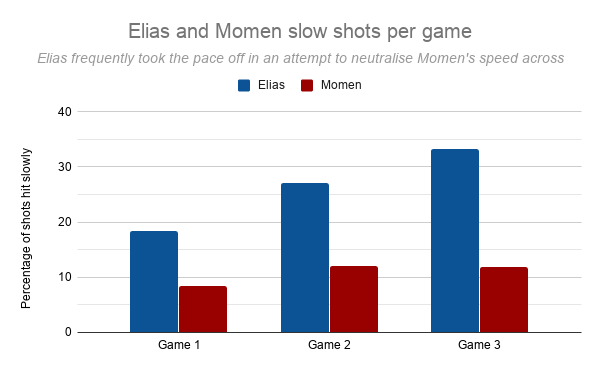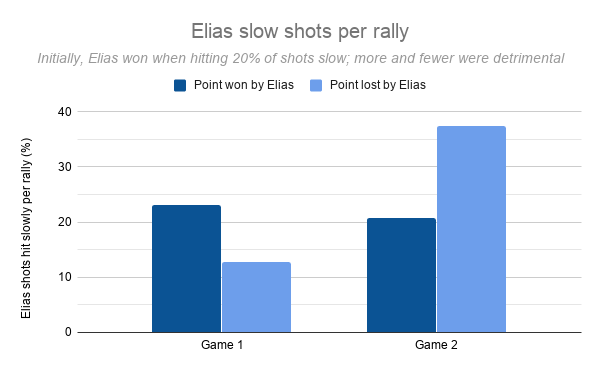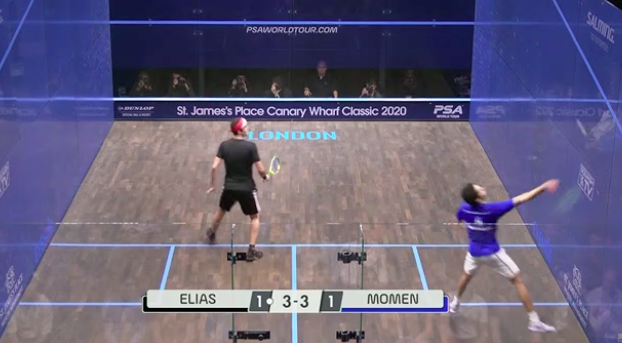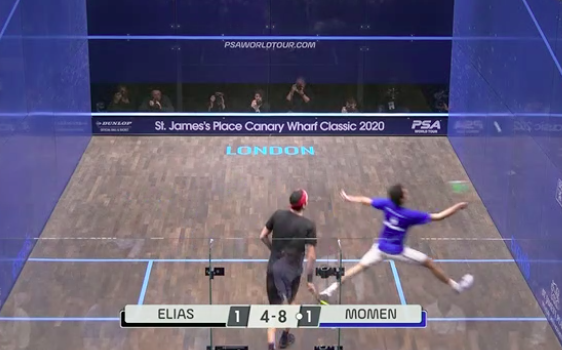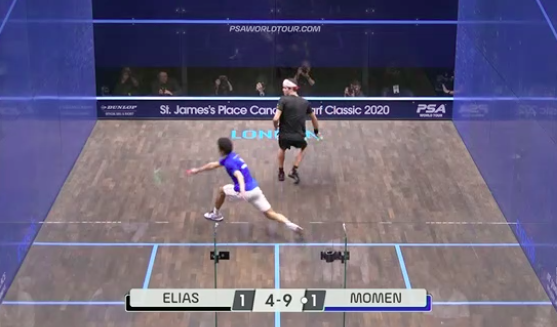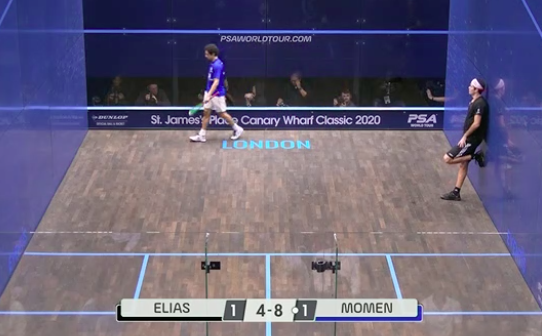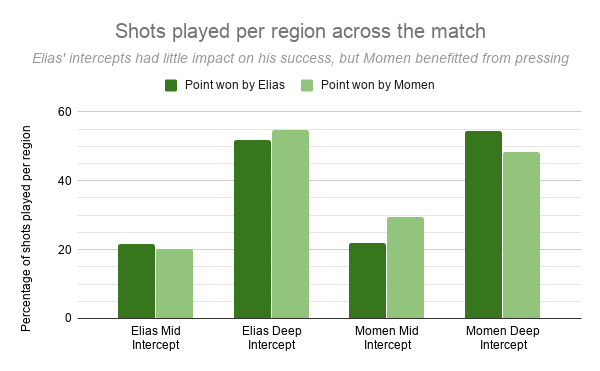The Puma and the Viper
The final men’s PSA World Tour competition to take place before COVID-19 closed courts around the globe was the 2020 Canary Wharf Classic. Against the backdrop of one of London’s financial districts, this gold level tournament is always a tour favourite. In this piece, Cross Court takes a look at the most intriguing match-up of the quarter-finals, seeing Peruvian Puma Diego Elias drawn against Egypt’s Tarek Momen.
Momen, known as the Viper for his pace across court, has played the best squash of his career in the past eighteen months, reaching the heights of world number three to go with his 2019 World Championship title. This was always going to be a tough draw for the maturing Peruvian. Yet, despite his underdog status, after 30 minutes of play, the score was locked at 3-3 in the final game. We examine the stats behind the tactics which saw him keep the match all square, before reviewing how the Viper raised his game in the final sprint to ultimately claim a 2-1 victory.
Slowing the pace
Playing a speed merchant is many club players’ worst fear. And even in the professional game, it warrants a rethink of traditional tactics. One common way of dealing with an opposing player’s speed is to take pace off your shots, hitting a high percentage of lobs from the front and slower drives from the back. Such tactics are favourable for several reasons. Firstly, they buy you time to return to the T, neutralising your opponent’s desire to play early and catch you out of position. They also ensure your opponent has to generate all the pace in their shots themselves, a frustrating and tiring undertaking. Additionally, your opponent is never able to settle into a rhythm of shots.
Unsurprisingly, the players’s differing approaches are reflected neatly in the number of times they looked to slow the game. In all three games, Elias hit substantially more slow shots than Momen.
If Elias could take Momen’s pace out the equation, he would be taking a big stride towards beating the Egytpian. Initially, he did just that. As shown below, in those Game 1 points won by the Peruvian, he took the pace off on 23.1% of shots. Similarly, in Game 2, Elias won those points in which he played one in five shots (20.9%) softly. Momen, by contrast, hit just 8.4% of his shots softly in Game 1, and 12.0% in Game 2. Two games in and it was one apiece: Elias’ game-plan was working.
Images taken from SquashTV coverage
But the margin for error at the top of professional sport is slim. It is noteworthy that any fluctuation from Elias’ one-in-five slow shots mark – in either direction – saw Momen take the point. In those Game 1 points won by Momen, Elias hit only 12.3% of shots softly. In Game 2, the opposite held true, with Momen winning those points in which Elias took the pace off too predictably, on a towering 37.5% of shots. Take the pace off too infrequently, and Elias was playing to Momen’s strengths; but employ this tactic too readily, and Elias’ game became too easy to read.
Opposing forces
If slowing the tempo is a tactic employed to neutralise an opponent’s pace, players who thrive when bringing pace to the fore tend to look to other tactics. Two common weapons in a speedster’s arsenal are high volley rates and a desire to push higher up the court – reflected in a high percentage of mid- and advanced- court intercepts. Both these tactics increase the tempo of the match, and give an opponent less recovery time between shots.
Predictably, the rate with which Momen and Elias volleyed belied their approaches to this encounter. Across the match, Elias’ volleyed 16.7% of shots; Momen, by contrast, hit 23.4% of his shots before the bounce. More instructive still is the outcome of a given point when considering the players’ volley rates. As illustrated in the graph below, Elias’ volley rate remained constant regardless of whether he won the point or not. Momen, however, benefited enormously from volleying. When the Puma could limit the Viper to a volley every five shots – in line with his own level – the Peruvian tended to win the rally; but when Momen could volley over a quarter of shots, he put the Puma to the sword.
The Viper’s rebuttal
With the match all square heading into the final game, why was Momen able to canter away from Elias? It is no coincidence that Game 3 saw the Egyptian’s highest volley rate of the encounter. With the match locked at 3-3 in the third, Momen flicked the volley switch. From then on, the Viper volleyed a remarkable 30.5% of shots, 9 percentage points up on his volley rate of 21.7% up to that point. This volley increase stretched an already tiring Elias, giving him less and less time to recover between strokes. While he may have let an Elias lob or drive rebound off the back wall in Games 1 and 2, Momen volleyed everything he could reach in Game 3, as shown in the stills below:
Images taken from SquashTV coverage
The volley pressing didn’t stop there. Even Elias’s drives from the front were cut off early by Momen in Game 3. The tactic, draining Elias of breath, is testament to Momen’s incredible movement and stamina. When Elias propped himself against the wall for a breather at 8-4, Momen must have known his approach was working.
Images taken from SquashTV coverage
Momen’s ability to increase the tempo in Game 3 is also reflected neatly in his intercept positions. While having higher mid-court intercept figures across the encounter, the discrepancy between the players was largest in the final game. In those Game 3 points he won, Momen hit 30.3% of shots from mid-court, suggestive of early interception of Elias’ attempted deep shots; this figure contrasts starkly with those Game 3 points won by Elias, in which Momem hit just 20.0% of shots from this region.
Furthermore, at 3-3 in the third – the point at which Momen pulled away from Elias – Momen had hit 53.1% of shots from deep; in the final points, he hit just 45.1% of shots from this region, a decrease of 8 percentage points, and indicative a player doing all in his power to quicken the pace of the tie.
Less is more for Elias; Press is more for Momen
The pattern of the encounter is striking. When Elias slowed the tempo every five shots, the match was finely balanced. Lobs and slow drives successfully neutralised Momen’s pace, while the still relative infrequency of such shots did not afford Momen the luxury of easy anticipation.
As the match wore on, though, Momen turned the screw. Increasing his volleys and early intercepts, the Viper turned Boa to squeeze the oxygen out of the Peruvian’s lungs, giving him less and less recovery time. With the match appearing locked at 3-3 in the final game, Momen won 7 of the next 8 completed rallies and booked himself a place in the semi-final.
A mature head on young shoulders
If the second game collapse phased her, El Hammamy certainly didn’t seem to show it. With El Sherbini leading 9-4 in the fifth, commentator Jenny Duncalf was readying her ceremony notes in praise of the World Champion on her return from injury. But the Gazelle hadn’t read the script, stringing together a run of points to claim the final game 13-11. The best strikers forget the open goal miss and slot home the next pull-back; the most successful swing bowlers ignore the cover drive for four and take the edge with the same delivery next time around. Errors might have undone her good work at the end of the second game, but in these business end points of the final game El Hammamy made not a single error.
More impressive yet was El Hammamy’s clarity of thought under pressure. Throughout the match, she hit winner after winner with a cross court drop, illustrated in the still below.
Images taken from SquashTV coverage
At 9-8 in the fifth, a similar opportunity presented itself. But instead of replicating the tactic that had brought her success thus far, El Hammamy had the presence of mind to change it up. Opting against the cross court drop, she hit a drive winner down the line to square the game at 9-9, just the fourth time in 103 points that she had hit the ball past El Sherbini for a winner.
El Sherbini’s body angle is set up to retrieve the cross court drop, but El Hammamy switched it up to fire it behind her
In putting the second game meltdown to one side, and in trusting her ability to use a shot she’d hardly unveiled all match, El Hammamy displayed levels of maturity well above her 19 years of age. 3-2, 13-11 in the fifth. The crowning moment in the tournament that Hania El Hammamy confirmed her place at squash’s top table. All the signs point to her dining there for many years to come.

